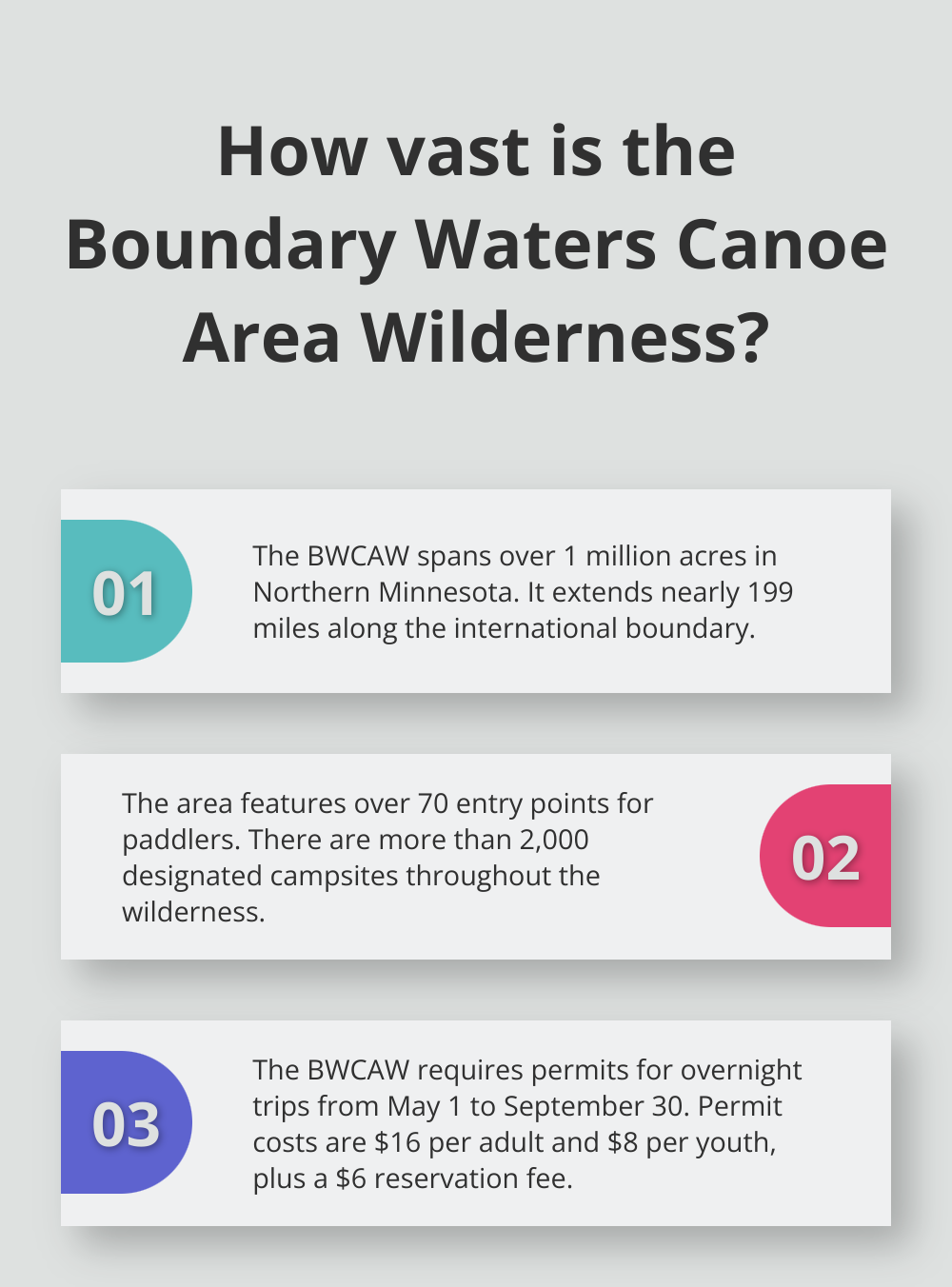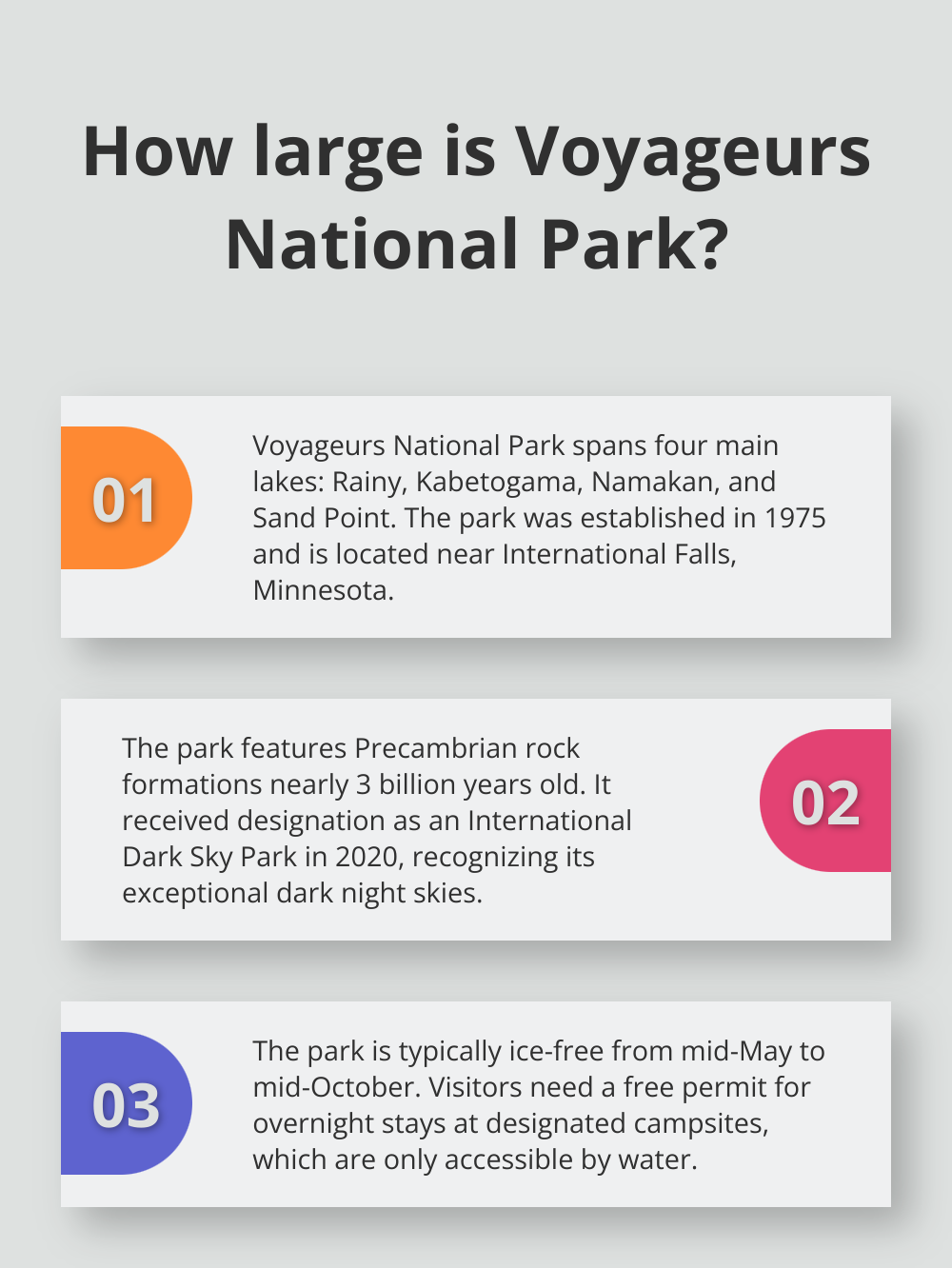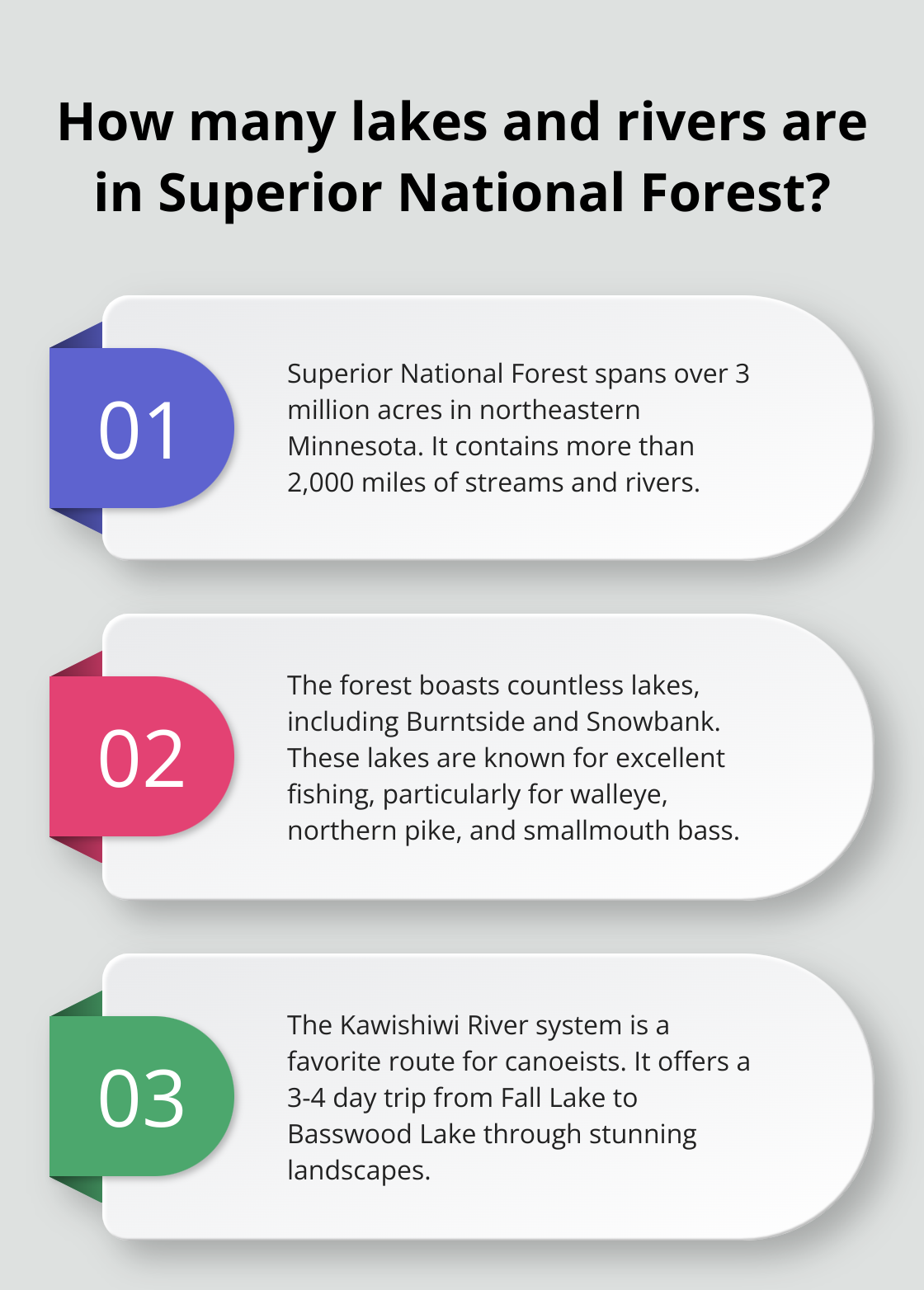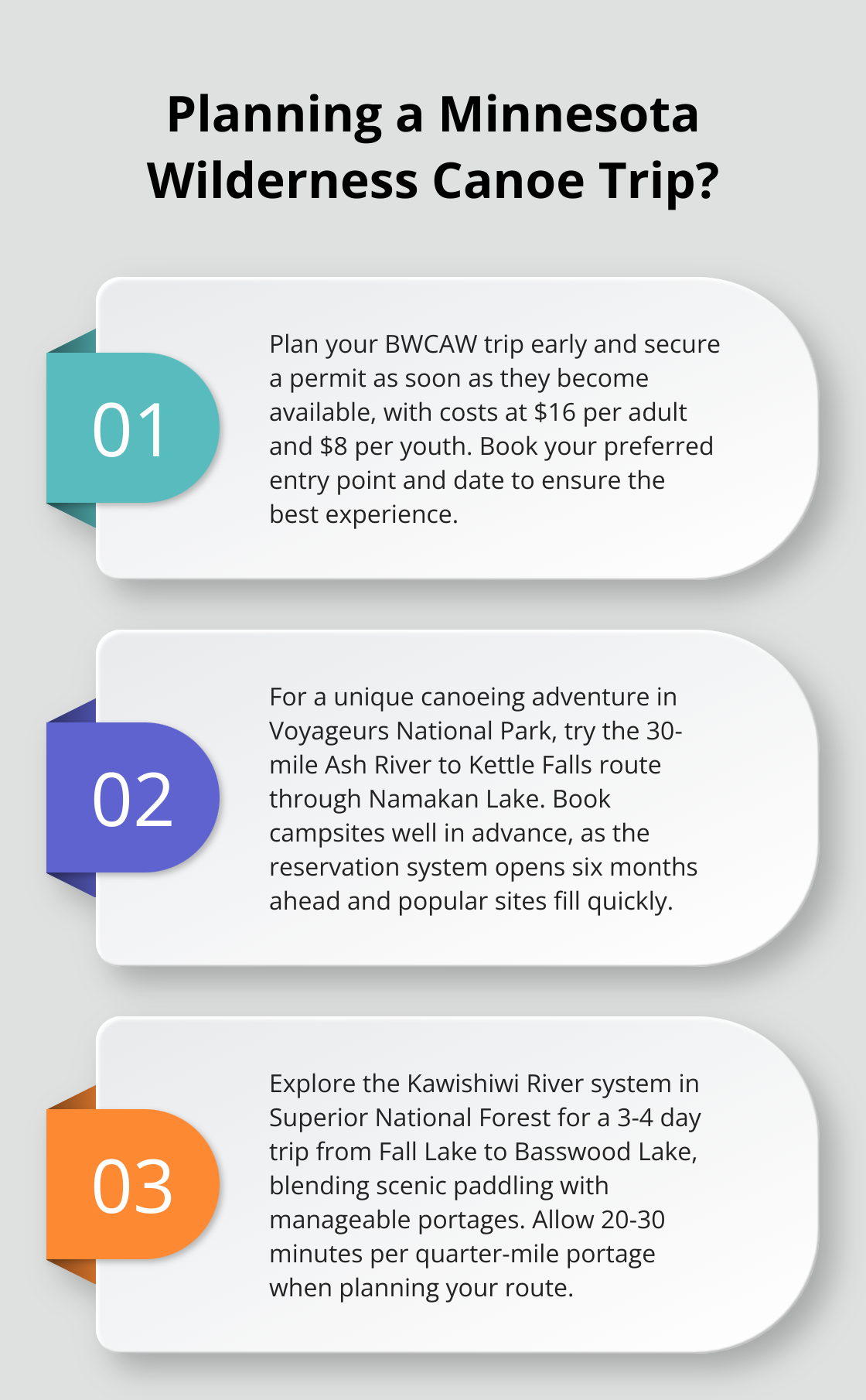Northern Minnesota’s pristine lakes and winding rivers offer some of the most breathtaking canoe trips in the country. From the iconic Boundary Waters to the hidden gems of Superior National Forest, paddlers can immerse themselves in untouched wilderness and rich natural beauty.
At Up North Property Management, we’ve explored these waterways extensively and are excited to share our favorite routes with you. Join us as we navigate through the best Northern Minnesota canoe trips, providing insider tips and essential information for your next adventure.
Exploring the Boundary Waters Canoe Area Wilderness
The Boundary Waters Canoe Area Wilderness (BWCAW) stands as a paddler’s paradise, spanning over 1 million acres of pristine lakes, rivers, and forests in Northern Minnesota. This vast wilderness area extends nearly 199 miles along the international boundary, offering unparalleled opportunities for canoeing, camping, and nature connection.
Entry Points and Popular Routes
The BWCAW features over 70 entry points, each leading to unique adventures. Some of the most popular entry points include:
- Moose Lake near Ely
- Sawbill Lake north of Tofte
- Lake One east of Ely
These entry points provide access to well-traveled routes suitable for both beginners and experienced paddlers.
One classic route is the Kawishiwi Triangle, which starts from Lake One. This 3-4 day trip takes you through a series of interconnected lakes, offering a mix of paddling and portaging. Another favorite is the Gunflint Trail route, which starts at Seagull Lake and offers stunning views of towering pines and rocky cliffs.
Wildlife and Natural Wonders
The BWCAW hosts a diverse array of wildlife. Paddlers often spot:
- Moose wading in shallow waters
- Bald eagles soaring overhead
- Otters playing along the shoreline
Lucky visitors might even catch a glimpse of a black bear or hear the haunting call of a loon echoing across the lake.

The area’s geology impresses equally. Ancient rock formations (some dating back over 2 billion years) create a rugged landscape of cliffs, islands, and hidden coves. The clear waters of the BWCAW are so pure that many visitors drink directly from the lakes (though we always recommend using a water filter for safety).
Camping and Permit Information
Camping in the BWCAW provides a true wilderness experience. Over 2,000 designated campsites scatter throughout the area, each offering a fire grate and a latrine. These sites operate on a first-come, first-served basis, so it’s wise to start your day early to secure a prime spot.
Permits are required for all overnight trips into the BWCAW from May 1 to September 30. The permit system helps manage visitor numbers and preserve the wilderness character of the area. Permits become available throughout the year, but booking early gives you the best chance at getting the dates and put-ins you really want.
The cost for a BWCAW permit is $16 per adult and $8 per youth (0-17) per trip, plus a $6 reservation fee. Group sizes are limited to 9 people and 4 watercraft. To ensure you secure your desired entry point and date, we recommend booking your permit as soon as they become available.
As we move from the vast expanse of the Boundary Waters, let’s explore another gem of Northern Minnesota’s canoeing landscape: Voyageurs National Park. This unique water-based park offers a different, yet equally captivating, paddling experience.
Voyageurs National Park: A Water-Based Wilderness Adventure
A Unique Canoeing Experience
Voyageurs National Park, located in northern Minnesota, offers a canoeing experience unlike any other in the United States. This water-based park, established in 1975, is located near the city of International Falls.
Navigating the Park’s Waterways
The park’s four main lakes – Rainy, Kabetogama, Namakan, and Sand Point – form the backbone of its canoe routes. Each lake presents its own character and challenges. Rainy Lake, the largest, offers expansive views and numerous islands to explore. Kabetogama Lake, with its intricate shoreline, provides excellent opportunities for wildlife viewing.

For a multi-day adventure, we recommend the Ash River to Kettle Falls route. This 30-mile journey takes you through Namakan Lake, offering a mix of open water paddling and sheltered passages. The trip ends at the historic Kettle Falls Hotel, a rustic lodge dating back to 1910 where you can rest and resupply.
Historical Significance and Unique Features
Voyageurs National Park takes its name from the French-Canadian fur traders who traversed these waters in the 18th and 19th centuries. Their legacy remains evident in the park’s landscape, from ancient pictographs to abandoned gold mines.
One of the park’s most distinctive features is its abundance of exposed Precambrian rock (some of the oldest visible rock on Earth at nearly 3 billion years old). These ancient formations create a rugged, island-dotted landscape that captivates paddlers.
The park also boasts exceptional dark skies. In 2020, it received designation as an International Dark Sky Park, recognizing the exceptional quality of its dark night skies and the park’s commitment to preserving darkness.
Planning Your Voyageurs Canoe Trip
When planning your Voyageurs canoe trip, consider the timing carefully. The park typically remains ice-free from mid-May to mid-October. Summer offers warm temperatures but can get busy, while fall provides stunning colors and fewer crowds.
Unlike the Boundary Waters, Voyageurs doesn’t require entry permits for day use. However, you’ll need a free permit for overnight stays at designated campsites. These sites, accessible only by water, often feature tent pads, fire rings, and bear-proof food lockers.
We recommend booking your campsite well in advance, especially for peak summer weekends. The park’s reservation system opens six months ahead, and popular sites fill quickly.
For those new to wilderness canoeing, hiring a guide or joining a ranger-led program can enhance your experience. The park offers various educational experiences, from guided paddles to evening programs at visitor centers.
Lastly, prepare for motorized boat traffic, particularly on the larger lakes. While this differs from the tranquility of the Boundary Waters, it also means easier access to supplies and emergency services if needed.
As we leave the expansive waters of Voyageurs National Park, let’s turn our attention to another gem of Northern Minnesota’s canoeing landscape: Superior National Forest. This vast wilderness area offers a different, yet equally captivating, paddling experience.
Canoeing Superior National Forest
A Vast Wilderness for Paddlers
Superior National Forest spans over three million acres in northeastern Minnesota. It boasts more than 2,000 miles of streams and rivers, along with countless lakes. This vast wilderness area provides a paradise for paddlers who seek solitude and natural beauty.
Hidden Gems for Canoe Enthusiasts
While the Boundary Waters often take center stage, Superior National Forest contains numerous lesser-known waterways perfect for canoeing. The Temperance River, which flows through the forest’s southern portion, offers an exhilarating day trip with its series of rapids and waterfalls. For a more relaxed paddle, Crescent Lake near Tofte provides calm waters and excellent wildlife viewing opportunities.

The Kawishiwi River system stands out as a favorite route. This network of interconnected lakes and rivers blends scenic paddling with manageable portages. The route from Fall Lake to Basswood Lake presents a 3-4 day trip through some of the forest’s most stunning landscapes.
Navigating Portages and Campsites
Portaging forms an integral part of canoeing in Superior National Forest. The Forest Service maintains portage trails, which range from short carries to challenging multi-mile treks. When planning your route, allow about 20-30 minutes per quarter-mile portage (depending on your group’s experience and load).
Camping in Superior National Forest offers more flexibility than the Boundary Waters. Dispersed camping is permitted throughout most of the forest, which gives paddlers the freedom to set up camp wherever they choose. However, using established campsites when possible helps minimize environmental impact.
Fishing in Forest Waters
Superior National Forest has earned a reputation for excellent fishing. Lakes like Burntside and Snowbank attract anglers seeking walleye, northern pike, and smallmouth bass. The forest’s streams also provide fantastic opportunities for trout fishing. (Don’t forget to obtain a Minnesota fishing license before casting your line.)
For the best fishing experience, consider hiring a local guide. They can provide valuable insights on the best spots and techniques for the season. If you need recommendations for reputable guides, Up North Property Management can connect you with experts who know these waters intimately.
Planning Your Forest Adventure
When planning your Superior National Forest canoe trip, consider the season carefully. Late spring and early fall offer fewer crowds and cooler temperatures, which prove ideal for longer portages. However, summer provides warmer waters for swimming and longer daylight hours for extended paddling.
Always check current conditions before your trip. The Forest Service website provides updates on water levels, fire restrictions, and trail conditions. For those new to wilderness canoeing, the Forest Service offers free paddling clinics throughout the summer at various ranger stations (a great opportunity to learn from experts).
Final Thoughts
Northern Minnesota canoe trips offer unparalleled experiences in pristine waterways. From the Boundary Waters to Voyageurs National Park and Superior National Forest, paddlers encounter natural beauty, wildlife, and outdoor adventure. These destinations cater to all skill levels, providing a perfect blend of tranquility and excitement.

Proper planning enhances your canoeing adventure. Secure permits early, pack appropriate gear, and practice Leave No Trace principles. You will preserve these environments for future generations and ensure a smooth trip. A reliable water filtration system proves essential for your journey through Minnesota’s north woods.
Up North Property Management can elevate your Northern Minnesota canoeing experience. We offer vacation rental management in the Northern Lakes Area, providing comfortable bases for your paddling adventures. Our local expertise helps plan perfect canoe trips, connecting you with trusted outfitters and guides (if needed).
